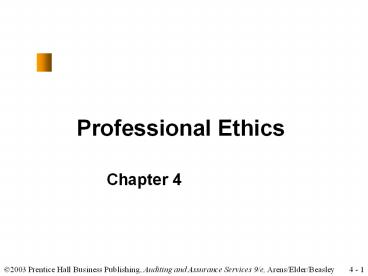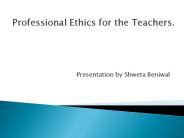Professional Ethics - PowerPoint PPT Presentation
Title:
Professional Ethics
Description:
Professional Ethics Chapter 4 Learning Objective 1 What are Ethics? Need for Ethics Why People Act Unethically Prescribed Ethical Principles Example A Person s ... – PowerPoint PPT presentation
Number of Views:540
Avg rating:3.0/5.0
Title: Professional Ethics
1
Professional Ethics
- Chapter 4
2
Learning Objective 1
Distinguish ethical from unethical behavior in
personal and professional contexts.
3
What are Ethics?
Ethics can be defined broadly as a set of moral
principles or values.
Each of us has such a set of values.
We may or may not have considered them explicitly.
4
Need for Ethics
Ethical behavior is necessary for a society to
function in an orderly manner.
The need for ethics in society is
sufficiently important that many commonly held
ethical values are incorporated into laws.
5
Why People Act Unethically
The persons ethical standards are different from
those of society as a whole.
The person chooses to act selfishly.
In many instances, both reasons exist.
6
Prescribed EthicalPrinciples Example
Trustworthiness
Fairness
Respect
Caring
Responsibility
Citizenship
7
A Persons Ethical StandardsDiffer from General
Society
Embezzlers
Con artists
Shoplifters
Most people who commit such acts feel no remorse
when they are apprehended because their ethical
standards differ from those of society as a whole.
8
A Person Chooses toAct Selfishly Example
Person A finds a briefcase containing important
papers and 1,000.
He tosses the briefcase and keeps the money.
He brags to his friends about his good fortune.
This action probably differs from most of society.
9
A Person Chooses toAct Selfishly Example
Person B faces the same situation but responds
differently.
He keeps the money but leaves the briefcase.
He tells nobody and spends the money.
He has violated his own ethical standards and
chose to act selfishly.
10
Learning Objective 2
Resolve ethical dilemmas using an
ethical framework.
11
Ethical Dilemmas
An ethical dilemma is a situation a person faces
in which a decision must be made about
appropriate behavior.
12
RationalizingUnethical Behavior
Everybody does it.
If its legal, its ethical.
Likelihood of discovery and consequences
13
Resolving Ethical Dilemmas
1. Obtain the relevant facts.
2. Identify the ethical issues from the facts.
3. Determine who is affected.
14
Resolving Ethical Dilemmas
4. Identify the alternatives available to
the person who must resolve the dilemma.
5. Identify the likely consequence of each
alternative.
6. Decide the appropriate action.
15
Ethical Dilemma
A staff person has been informed that he will
work hours without recording them as hours
worked.
Firm policy prohibits this practice.
Another staff person has stated that this is
common practice in the firm.
16
Ethical Dilemma
Is it ethical for the staff person to work hours
and not record them as hours worked in this
situation?
Who is affected?
How are they affected?
What alternatives does the staff person have?
17
Learning Objective 3
Explain the importance of ethical conduct for
the accounting profession.
18
Special Need for Ethical Conduct in Professions
Our society has attached a special meaning to the
term professional.
A professional is expected to conduct himself or
herself at a higher level than most other members
of society.
19
CPAs Encouraged to ConductThemselves at a High
Level
CPA examination
GAAS and interpretations
Conduct of CPA firm personnel
Continuing education requirements
20
CPAs Encouraged to ConductThemselves at a High
Level
SEC
Peer review
Conduct of CPA firm personnel
Quality control
21
CPAs Encouraged to ConductThemselves at a High
Level
Legal liability
Division of CPA firms
Conduct of CPA firm personnel
Code of Professional Conduct
22
Learning Objective 4
Describe the purpose and content of the AICPA
Code of Professional Conduct.
23
Code of Professional Conduct
Principles
Ideal standards of ethical conduct in
philosophical terms
They are not enforceable.
Rules of conduct
Minimum standards of ethical conduct stated as
specific rules
They are enforceable.
24
Code of Professional Conduct
Interpretation of the rules of conduct
Interpretation of the rules of conduct by the
AICPA Division of Professional Ethics
They are not enforceable, but a practitioner must
justify departure.
25
Code of Professional Conduct
Ethical rulings
Published explanations and answers to questions
about the rules of conduct submitted to the AICPA
by practitioners and others interested in ethical
requirements
They are not enforceable, but a practitioner must
justify departure.
26
Ethical Principles
1. Responsibilities
Professionals should exercise sensitive and moral
judgments in all their activities.
2. Public Interest
Members should accept the obligation to act in a
way that will serve and honor the public.
27
Ethical Principles
3. Integrity
Members should perform all responsibilities with
integrity to maintain public confidence.
4. Objectivity and Independence
Members should be objective, independent, and
free of conflicts of interest.
28
Ethical Principles
5. Due Care
Members should observe the professions standards
and strive to improve competence.
6. Scope and Nature of Services
A member in public practice should observe the
Code of Professional Conduct.
29
Standards of Conduct
Ideal conduct
Principles
Rules of conduct
Minimum Level
Substandard conduct
30
Learning Objective 5
Describe factors that influence auditor
independence.
31
Independence
Independence means taking an unbiased viewpoint
in performing audit tests.
Independence in fact
Independence in appearance
32
Independence
Audit committee
Shopping for accounting principles
Approval of auditors by stockholders
Engagement and payment of audit fees by management
33
Revision of SEC Auditor Independence Requirements
Ownership interests
IT and other nonaudit services
ISB pronouncements and interpretations remain
enforceable unless they conflict with the
independence rulings issued by the SEC.
34
Learning Objective 6
Apply the AICPA Code rules and interpretations on
independence and explain their importance.
35
Independence
Rule 101 Independence
A member in public practice shall be independent
in the performance of professional services as
required by standards promulgated by
bodies designated by Council.
36
Financial Interests
Interpretations of Rule 101 prohibit covered
members from owning any direct investments in
audit clients.
Direct financial interest
Indirect financial interest
Material or immaterial
37
Related FinancialInterests Issues
Former practitioners
Normal lending procedures
Financial interest and employment of immediate
and close family
Joint investor or investee relationship with
client
Director, officer, management, or employee of a
company
38
Related FinancialInterests Issues
A lawsuit or intent to start a lawsuit between a
CPA firm and its client is a violation of Rule
101 for the current audit.
The interpretations permit a CPA firm to do both
bookkeeping and auditing for the same client.
The SEC prohibits performing bookkeeping and
auditing services by the same CPA firm.
39
Related FinancialInterests Issues
Internal auditing and extended audit services
Unpaid fees
40
Learning Objective 7
Understand the requirements of other rules under
the AICPA Code.
41
Rules of Conduct
101 Independence
102 Integrity and objectivity
201 General standards
202 Compliance with standards
203 Accounting principles
301 Confidential client information
42
Rules of Conduct
302 Contingent fees
501 Acts discreditable
502 Advertising and other forms of solicitation
503 Commissions and referral fees
505 Form of organization and name
43
Learning Objective 8
Describe the enforcement mechanisms for the rules
of conduct.
44
Enforcement
Action by AICPA Professional Ethics Division
Action by a State Board of Accountancy
Its all a matter of trust.
45
End of Chapter 4































